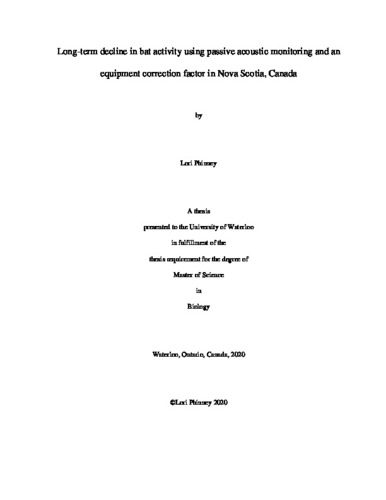| dc.contributor.author | Phinney, Lori | |
| dc.date.accessioned | 2020-09-28 15:16:49 (GMT) | |
| dc.date.available | 2020-09-28 15:16:49 (GMT) | |
| dc.date.issued | 2020-09-28 | |
| dc.date.submitted | 2020-09-21 | |
| dc.identifier.uri | http://hdl.handle.net/10012/16390 | |
| dc.description.abstract | Passive acoustic monitoring has grown in popularity as a technique to assess changes in activity levels of various taxa. However, there are few long-term and large-scale acoustic monitoring programs due to the current challenges associated with advancing technology, data management and analyses. The variation in the quality and quantity of acoustic data collected by different equipment setups has become challenging to avoid. There are an increasing number of equipment options that provide different or improved detection capabilities as old models wear and phase out. To assess long-term activity trends of bats between two data sets collected by different equipment in southwest Nova Scotia, Canada, I developed equipment variation correction factors. I compared the assumed proportion of successful detections as given by binomial distribution between two types of bat acoustic monitors positioned side by side. I found the proportion of successful Anabat SD1 to Song Meter SM4 detections to vary by night (n=5), height (3 m, 6 m) and species (Myotis lucifugus, Perimyotis subflavus). There was no systematic bias in the correction factors when I compared the Anabat to the corrected Song Meter detections as indicated by mean errors centered around zero. After applying the correction factors, acoustic activity of Myotis lucifugus declined by 95.50% 95% CI (96.96%, 93.59%) and Perimyotis subflavus declined by 91.37% 95% CI (92.99%, 89.49%) between 2005/2006 and 2018/2019 across southwest Nova Scotia. These trends reflect declines in winter colony counts and summer capture rates across eastern North America attributable to the disease White Nose Syndrome (WNS). My results demonstrate that direct comparisons of data sets collected by different acoustic equipment cannot be made and that equipment variation needs to be accounted for in order to assess long-term activity patterns. Exploring techniques to account for equipment variation and their efficacy will increase our ability to use acoustic data to track long-term population trends and manage wildlife populations. Managers can continue to use acoustics to assess population trends in areas with no known hibernation sites, for species difficult to study in hibernacula and to identify areas that may be significant for WNS recovery. In Nova Scotia, Kejimkujik National Park and National Historic Site may serve as an important area for WNS recovery. Periodic monitoring should continue to document population trends and this long-term data set may be used to track summer population changes. | en |
| dc.language.iso | en | en |
| dc.publisher | University of Waterloo | en |
| dc.subject | population monitoring | en |
| dc.subject | acoustic activity | en |
| dc.subject | equipment variation | en |
| dc.subject | Myotis lucifugus | en |
| dc.subject | Perimyotis subflavus | en |
| dc.subject | White-nose syndrome | en |
| dc.title | Long-term decline in bat activity using passive acoustic monitoring and an equipment correction factor in Nova Scotia, Canada | en |
| dc.type | Master Thesis | en |
| dc.pending | false | |
| uws-etd.degree.department | Biology | en |
| uws-etd.degree.discipline | Biology | en |
| uws-etd.degree.grantor | University of Waterloo | en |
| uws-etd.degree | Master of Science | en |
| uws.contributor.advisor | Broders, Hugh | |
| uws.contributor.affiliation1 | Faculty of Science | en |
| uws.published.city | Waterloo | en |
| uws.published.country | Canada | en |
| uws.published.province | Ontario | en |
| uws.typeOfResource | Text | en |
| uws.peerReviewStatus | Unreviewed | en |
| uws.scholarLevel | Graduate | en |

